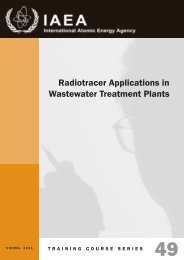Second Environmental Performance Review of Albania
Second Environmental Performance Review of Albania
Second Environmental Performance Review of Albania
Create successful ePaper yourself
Turn your PDF publications into a flip-book with our unique Google optimized e-Paper software.
Chapter 10: Human health and environment147The Law on Public Health requires all data collectedby the public health structures, along with data oninfectious diseases, to be channelled to IPH, whichprepares analytical reports on the health status <strong>of</strong> thepopulation, exposures to environmental risks andrelated health effects, for MoH. The Ministry is tosubmit biannual reports to the Council <strong>of</strong> Ministerswhich will then present them to the NationalAssembly. The public health structures have toperiodically report to the local governments in theareas they cover.The quality <strong>of</strong> services, equipment and personnelvaries among the 36 public health structures; inaddition, data collection and reporting is, in manycases, outdated, and covering the entire breadth <strong>of</strong>environmental public health services throughout thecountry in depth poses a significant challenge withlimited resources. MoH is currently undertaking aconsolidation <strong>of</strong> the health inspection regime as part<strong>of</strong> the initiative to pool together sectoral inspectionbodies with the aim <strong>of</strong> separating control andenforcement from the policy process. Optimization <strong>of</strong>the organizational structure and geographicalorganization <strong>of</strong> the public health system are alsounderway. As regards education, the Department <strong>of</strong>Public Health in the Medical Faculty <strong>of</strong> theUniversity <strong>of</strong> Tirana has since 2007 providedcapacity for public health pr<strong>of</strong>essionals.<strong>Environmental</strong> health is a compulsory andfundamental course in the public health and medicalcurriculum, and is part <strong>of</strong> postgraduate education andmedical specialization and <strong>of</strong> the postgraduatequalification.The NFA – the newly created body following EUregulations, which is directly subordinated toMoAFCP through its General Directorate <strong>of</strong> FoodSafety Policies and Consumer Protection – has takenover food safety and related consumer protectionissues. The Authority has now increased operationalcapacity and is expanding across the 12 regions,while its risk assessment and communicationcapacity is still to be developed. The backbone <strong>of</strong> theAuthority is the inspectorates <strong>of</strong> food and foodbusiness establishments, and <strong>of</strong> animal health, whichoperate at central and regional levels.Responsibilities for plant health, and coordinationand support for laboratories, are also carried out atcentral and regional levels, and the Food Safety andVeterinary Institute (ISUV) provides the referencelaboratories for food safety analysis and <strong>of</strong>ficialcontrols. In addition, at regional level there is a uniton self-controls and control-points-basedinformation.INSTAT is coordinator <strong>of</strong> the national statisticalsystem and, in the fall <strong>of</strong> 2011, conducted thepopulation and housing census. It collects mortalitydata from the health sector and civil registrars butdata from those two sources do not match and areavailable in highly aggregated form only. TheInstitute will host registers on injuries andtraumatism in occupational and transport settings.Intersectoral collaborationSeveral working groups involving both experts andpolicy-makers from different sectors are beinginvolved in the development <strong>of</strong> policy programmesand legislation, which demonstrates intersectoralcollaboration in the policy preparation phase. Theestablishment <strong>of</strong> long-term partnerships among thedifferent sectors for the implementation <strong>of</strong> policy andlegislation in the field <strong>of</strong> environment and health isvery limited. The ECS envisions some policymeasures for intersectoral collaboration, but there isno report on what has been implemented and whatworked. The national transport, environment andhealth intersectoral committee set up in the context <strong>of</strong>the UNECE/WHO Transport, Health andEnvironment Pan-European Programme (THE PEP)is still not functioning. The intersectoral workinggroup following up on the Fifth MinisterialConference on Environment and Health in Parma is,equally, not operational. In some rather particularcases – such as monitoring <strong>of</strong> urban air quality and <strong>of</strong>bathing waters when there is capacity and resources,mechanisms <strong>of</strong> inter-institutional communication,and clear definition <strong>of</strong> the tasks, includinginformation activities, data and reporting channels –intersectoral collaboration has been successful.The lack <strong>of</strong> policy-oriented monitoring andinformation support tools hinders intersectoralcollaboration during the entire policy process.Current monitoring and information systems focuseither on the state <strong>of</strong> the environment or on healthfrom a health-care perspective. Integratedassessments on the population’s health, involving theenvironmental and other economic sectors and usinga common language in the form <strong>of</strong> policy-relevantindicators such as those <strong>of</strong> the WHO/ENHIS system,are lacking. Furthermore, there are no periodicassessments <strong>of</strong> the health impacts <strong>of</strong> environmentalrisks which could provide strong argument forinvestment in “win-win” solutions benefiting bothpublic health and the environment.10.4 Conclusions and recommendationsIPH gathers data on key environmental healthexposures, such as air pollution and contaminateddrinking water, and on the health effects <strong>of</strong> degraded
















